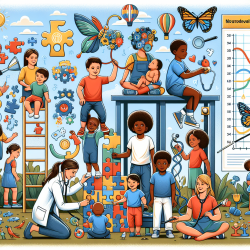Introduction
Adolescence is a critical period marked by significant physical and mental health developments. A recent study, "Relationships between Physical and Mental Health in Adolescents from Low-Income, Rural Communities: Univariate and Multivariate Analyses," sheds light on the interconnectedness of these health domains in adolescents from rural, low-income backgrounds. This research highlights the urgent need for targeted interventions to address these intertwined challenges, particularly in underserved populations.
Key Findings
The study, conducted with 253 tenth and eleventh-grade students from Title I schools in rural Alabama, utilized self-report measures and physical assessments to explore the relationship between physical and mental health. Key findings include:
- High Prevalence of Health Issues: The study found that adolescents in rural, low-income areas exhibit higher rates of obesity and mental health issues, such as anxiety and depression, compared to national averages.
- Correlations Between Health Domains: Positive correlations were identified between body composition and mental health symptoms, suggesting that physical health significantly impacts mental well-being.
- Sex Differences: Females reported lower physical activity and higher mental health symptoms than males, indicating a need for gender-specific interventions.
- Cluster Analysis: The study identified distinct clusters of adolescents based on their mental and physical health profiles, highlighting groups that may benefit from targeted interventions.
Implications for Practitioners
For practitioners working with adolescents in similar contexts, this study underscores the importance of adopting a holistic approach that considers both physical and mental health. Here are some actionable insights:
- Integrate Physical and Mental Health Interventions: Develop programs that simultaneously address physical fitness and mental health, leveraging the interconnectedness of these domains to enhance overall well-being.
- Focus on High-Risk Groups: Utilize data-driven approaches to identify adolescents with significant health burdens and tailor interventions to meet their specific needs.
- Gender-Sensitive Approaches: Design interventions that account for gender differences in health outcomes, ensuring that both male and female adolescents receive appropriate support.
- Community Engagement: Engage with local communities to understand cultural perceptions and barriers to accessing health services, ensuring that interventions are culturally sensitive and accessible.
Encouraging Further Research
While this study provides valuable insights, further research is needed to explore the mechanisms underlying the relationship between physical and mental health in rural adolescents. Future studies should aim to:
- Investigate the impact of socioeconomic status and environmental factors on health outcomes.
- Examine the effectiveness of integrated interventions in improving both physical and mental health.
- Explore the role of self-esteem and body image in mediating health outcomes.
For practitioners and researchers interested in delving deeper into these findings, the original research paper provides a comprehensive analysis of the data and methodologies used. Relationships between Physical and Mental Health in Adolescents from Low-Income, Rural Communities: Univariate and Multivariate Analyses.










